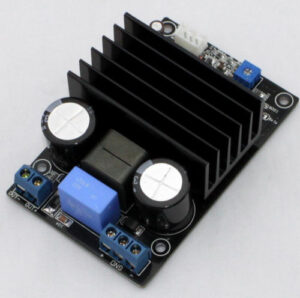Having sorted the basic shape and selected a driver, it’s time to pay attention to amplification.
The driver is rated for 120W continuous, with 180W peak, so an amplifier capable of about 200W should do fine. Since the amplifier will go inside the box, efficiency is important, even if the heatsink can stick out of the box in the back. Class D amplifiers are very popular, since they are compact relative to their power, are highly efficient, typically 80% – 90% and also provide high audio quality.
The last part isn’t really critical in a subwoofer, since the human ear isn’t particularly sensitive in the sub 120Hz region, but it would be pretty annoying to have the amplifier add distorsion above 120 Hz in a range where the speaker element can reproduce it, and even inaudible noise can damage the driver if it is strong enough.
After browsing the Internet for class D modules, I found quite a few based on the same chip, the IRS2092S but with very different power ratings, even a 2500W monster. Something close to the reference design is available from countless sellers on eBay, costing from $15 – $30 (yes, identical boards!), with free shipping. They all come from Yuan Jing Audio, and all claim to use “Nikon” capacitors. (Yuan Jing themselves state that the capacitors are Nichicon, which is more likely, and may or may not be true.)
Despite the module being 90% efficient, heat may become a problem in a 35l box. Also, the big caps (largish cans) are placed very close to the heatsink, and excessive heat will shorten their life significantly. If heat becomes a problem, there is one cure to try; putting the heatsink on the outside and moving the power transistor to the underside of the board. That might be a little tricky, since this module doesn’t use standard MOSFETs but a clever little half-bridge called IRFI4019. This half-bridge is part of the magic behind the performance of the audio module, and adding a couple of cm to the length of the pins on that 5-pin package may get it out of whack enough to start to oscillate, and fry  the expensive woofer element while emitting some serious RF energy. I’ll settle for monitoring the heat for now.
Another issue is the power supply. This YJ-module requires a symmetrical, ±30V – ±60V supply, while many other modules are happy with a positive supply only. There are a few options. One is to use a single 200W switcher with dual outputs, but that is pretty hard to find for a reasonable price, or two 100W switchers, which will drive up the price and size of the solution. Also, cheap chinese mains-powered stuff have a reputation for poor electrical safety… Leaves option three, a traditional linear, unregulated supply. All thats really needed is a transformer, a rectifier, a few fuses and some capacitors.
More about that in part #3.

